What are Perennial Weeds?
Perennial Weeds are longer lived plants that can survive winter or regrow from roots, rhizomes or tubers in spring after a period of dormancy. Many weeds that grow from seed ...

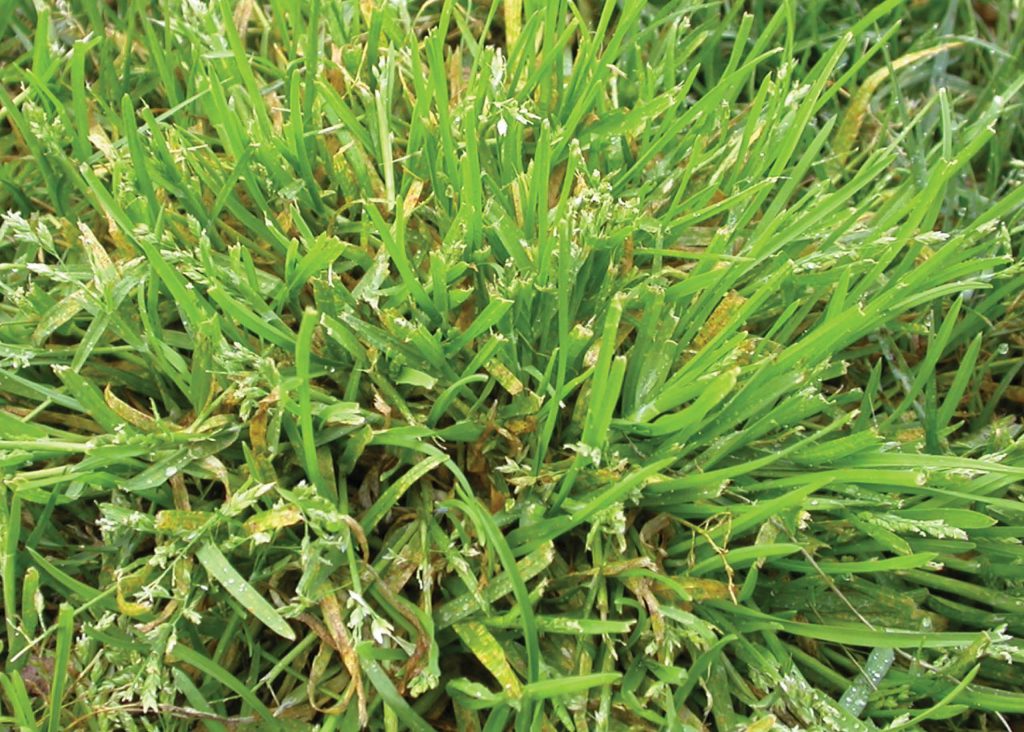 Weeds are a common problem in most Australian gardens, impacting the look, and sometimes the feel of your lawn. Grass weeds are especially good at surviving, as they are often able to camouflage within the grass, and quickly take over and ruin your beautiful lawn.
Weeds are a common problem in most Australian gardens, impacting the look, and sometimes the feel of your lawn. Grass weeds are especially good at surviving, as they are often able to camouflage within the grass, and quickly take over and ruin your beautiful lawn.
Established weeds can be hard to eradicate, so the key to managing grass weeds is to get in early and prevent them from spreading. In this article, we’ll go through how to identify some common grass weeds, and how to get rid of them.
Grass weeds is a term broadly used to describe a variety of grass-like weeds, that are typically found in lawns, garden beds, and are well-adapted to growing in our climate. Because of their grass-like appearance, they can often be overlooked, allowing them to spread quickly and making them difficult to control.
Just like other plants, grass weeds can be annual or perennial plants, which refers to their ability to regrow each year.
As the name suggests, annual weeds grow for a single year, and then die. They grow from seed, and annual weeds will typically produce many seeds which will produce new plants the following year.
By contrast, perennial weeds can live for two years or more. They grow from both seeds and root material, which allows them to regrow from the same root system every year.
Learning to identify the difference between broadleaf weeds and grassy weeds is important to choose the right method of control for your lawn.
Broadleaf weeds, as the name suggests, have wide leaves with a main vein in the centre. Aside from this, broadleaf weeds are a diverse category, with many different characteristics. They can be either annual or perennial; low-growing or upright, and can appear in both summer and winter.
Grassy weeds are so called because of their resemblance to lawn grasses. This often makes them more difficult to identify than broadleaf weeds. Grassy weed blades emerge as a single leaf, and grow to have round, hollow stems and hard, closed joints (nodes) with alternating leaf blades on each side.
 Winter Grass is a widespread weed problem throughout Australia and is more prevalent in winter and spring. Winter Grass is characterized by prolific seed production, which can make it hard to manage. If seeds appear, they will quickly germinate, and, more than likely, you will have Winter Grass on your lawn again the following year. It is a pale green colour with smooth leaves and has a white cotton-like root zone.
Winter Grass is a widespread weed problem throughout Australia and is more prevalent in winter and spring. Winter Grass is characterized by prolific seed production, which can make it hard to manage. If seeds appear, they will quickly germinate, and, more than likely, you will have Winter Grass on your lawn again the following year. It is a pale green colour with smooth leaves and has a white cotton-like root zone.
 Crowsfoot grass is a low-growing, hardy annual weed that thrives during spring, summer, and autumn. It grows in all soil conditions and can survive in heavily compacted areas where Couch grass will not grow. In climates not subject to frost, it may survive for more than a year. This grass has semi-upright, spreading stems and narrow, hairless leaf blades. Crowsfoot Grass has seed-heads that radiate outwards from the same point, and flower spikelets that are densely arranged along the seed-head branches.
Crowsfoot grass is a low-growing, hardy annual weed that thrives during spring, summer, and autumn. It grows in all soil conditions and can survive in heavily compacted areas where Couch grass will not grow. In climates not subject to frost, it may survive for more than a year. This grass has semi-upright, spreading stems and narrow, hairless leaf blades. Crowsfoot Grass has seed-heads that radiate outwards from the same point, and flower spikelets that are densely arranged along the seed-head branches.
 Crabgrass is a prolific seeder and spreader, overtaking lawns as it continues to spread.
Crabgrass is a prolific seeder and spreader, overtaking lawns as it continues to spread.
It suffocates your lawn and then dies off in winter, leaving bare patches. Following spring the bare patch becomes a stronger weed from the previous season’s seeding and the problem continues to deteriorate. Crabgrass grows flat along the ground with wide leaves on very tough and wiry stems. The leaves of young plants will be rolled over in half, opening as the leaf matures. Masses of seeds are produced on several finger-like branches on top of the numerous stems produced by each plant.
 Summer Grass is a common fast-growing weed, found Australia-wide, that sends out shoots in all directions from its centre during conditions of high heat and humidity.
Summer Grass is a common fast-growing weed, found Australia-wide, that sends out shoots in all directions from its centre during conditions of high heat and humidity.
It spreads prolifically through its stolons, with stems that can be brown or red in colour and thin grey-green leaves with fine spiky seed heads that shoot upwards.
Summer Grass goes to seed during autumn and reemerges the following year if not controlled.
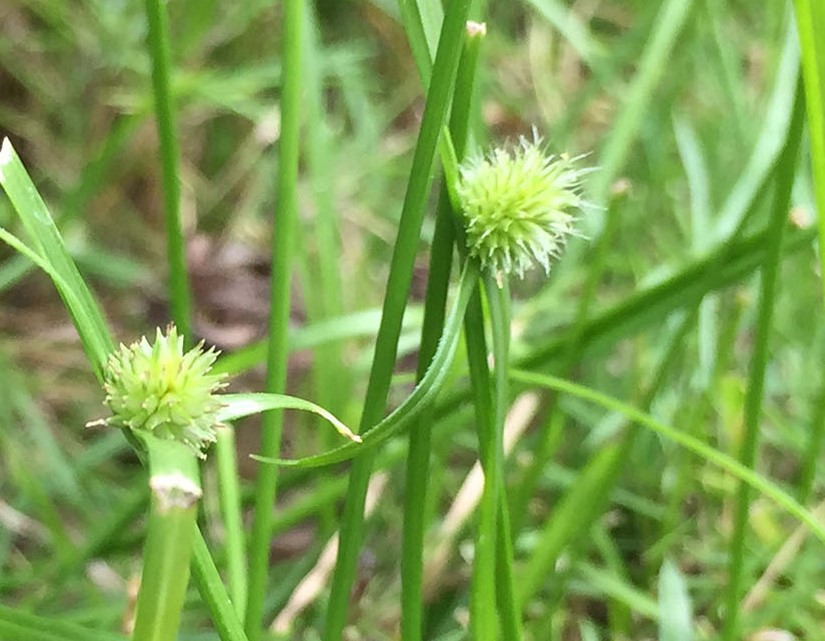 Mullumbimby Couch is a mat-forming grass-like sedge plant with long underground runners and upright flowering stems measuring up to 40cm in height. It grows year-round, and
Mullumbimby Couch is a mat-forming grass-like sedge plant with long underground runners and upright flowering stems measuring up to 40cm in height. It grows year-round, and
features bright green leaves that are hairless and sheath the stem at the base.
Its pale green seed-heads have three or four green leafy bracts at the base and contain numerous small flower spikelets which appear throughout spring and summer.
Conducive growing conditions for Mullumbimby Couch occur when there is excessive soil moisture and humidity.
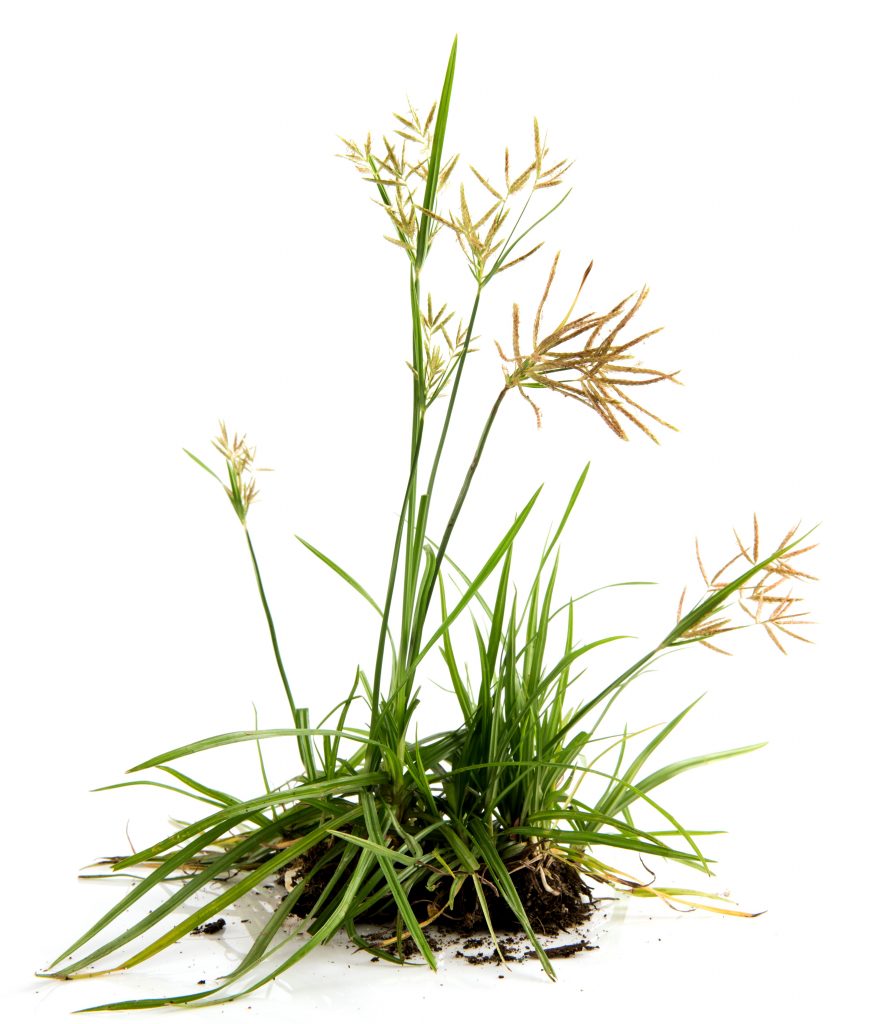 Nut Grass can be found on your lawn year-round and is known as a sedge weed.
Nut Grass can be found on your lawn year-round and is known as a sedge weed.
It usually grows to about 20cm to 50cm in height and produces a network of creeping underground stems with small tubers.
Nut Grass has upright flowering stems that are smooth and three-angled in cross section.
The weed has very narrow leaves and seed heads have three to eight branches that vary in length.
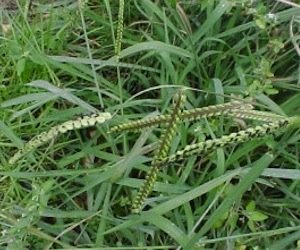 Paspalum is a difficult weed to control. It is a long-lived tufted grass growing up to 1.5m tall with slightly folded leaf blades at the base which are usually hairless.
Paspalum is a difficult weed to control. It is a long-lived tufted grass growing up to 1.5m tall with slightly folded leaf blades at the base which are usually hairless.
Paspalum’s seed-heads are borne at the tips of upright flowering stems and have 2-11 branches that are alternatively arranged along the main stalk. Each Paspalum seed-head branch bears numerous small flower spikelets that are covered with hairs.
Paspalum mainly grows throughout the warmer months from late spring to autumn.
The weed prolifically spreads through its sticky seeds which easily grasp onto pets and shoes before being relocated.
 Oxalis can appear like a miniature clover plant, but it bears tiny yellow flowers. It is a perennial weed, which spreads through interlocking rhizomes that are easy to break apart; these rhizomes eventually produce tiny bulbils.
Oxalis can appear like a miniature clover plant, but it bears tiny yellow flowers. It is a perennial weed, which spreads through interlocking rhizomes that are easy to break apart; these rhizomes eventually produce tiny bulbils.
The seeds of Oxalis are prolific and ejected when ripe from tiny seed pods that look like mini okra. Anywhere the stem touches the ground the Oxalis weed can root, potentially producing more and more plants.
 Dandelions have green leaves edged with teeth’ that grow mostly flat to the ground and are distinguished by their bright yellow flowers that fade to form a white puffball.
Dandelions have green leaves edged with teeth’ that grow mostly flat to the ground and are distinguished by their bright yellow flowers that fade to form a white puffball.
They appear in spring and autumn in lawns that aren’t as full and healthy as they could be. Above-ground, Dandelion seeds ride the wind currents, and drop into the slightest opening in your lawn and propagate. Below-ground, the Dandelion weed lays down a taproot up to 25cm long however, pulling the taproot as a means of removal is problematic. The Dandelion’s thick, brittle roots easily split, and any fraction left behind will regenerate.
 White Clover is a classic, three-leaf clover with bright green leaves adorned with white crescent shapes. It appears from spring through to autumn and usually in thin lawns with nutrient-poor soil. White Clover grows in a creeping manner and will develop roots wherever a stem node touches the ground. The flowers on White Clover are spiky and white with a brownish green centre.
White Clover is a classic, three-leaf clover with bright green leaves adorned with white crescent shapes. It appears from spring through to autumn and usually in thin lawns with nutrient-poor soil. White Clover grows in a creeping manner and will develop roots wherever a stem node touches the ground. The flowers on White Clover are spiky and white with a brownish green centre.
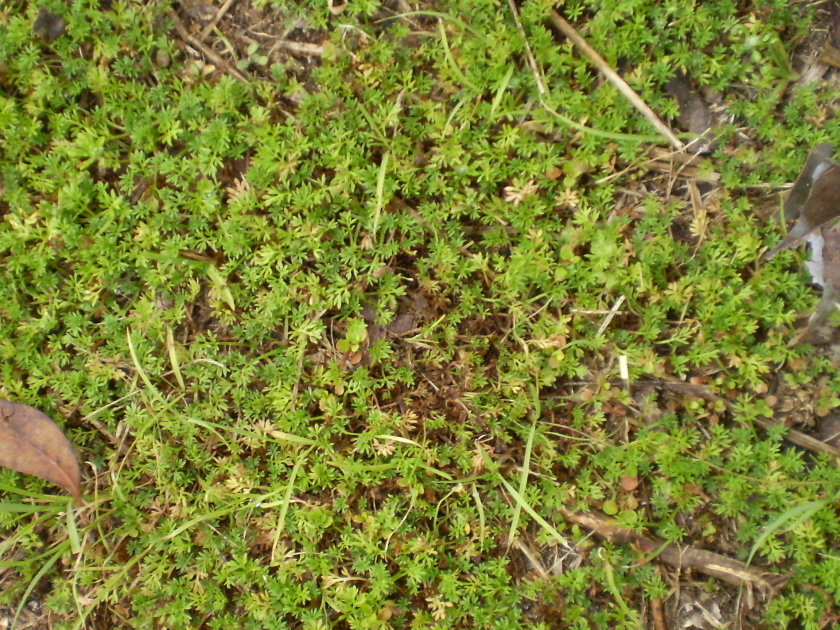 Bindii is a low growing weed. It produces a single flower in the middle, and at maturity produces a prickly seed pod. Bindii can be easily treated and removed by common and easy methods. The continuing lifecycle of bindii weeds really can’t be controlled by regular lawn mowing. Mowing doesn’t control the lifecycle of the weed as seed heads and flowers are below almost all mowing heights. Hand weeding is an obvious and effective treatment for bindii, as well as turning over the small seedlings. Selective and non-selective herbicides can be used to easily control bindii.
Bindii is a low growing weed. It produces a single flower in the middle, and at maturity produces a prickly seed pod. Bindii can be easily treated and removed by common and easy methods. The continuing lifecycle of bindii weeds really can’t be controlled by regular lawn mowing. Mowing doesn’t control the lifecycle of the weed as seed heads and flowers are below almost all mowing heights. Hand weeding is an obvious and effective treatment for bindii, as well as turning over the small seedlings. Selective and non-selective herbicides can be used to easily control bindii.
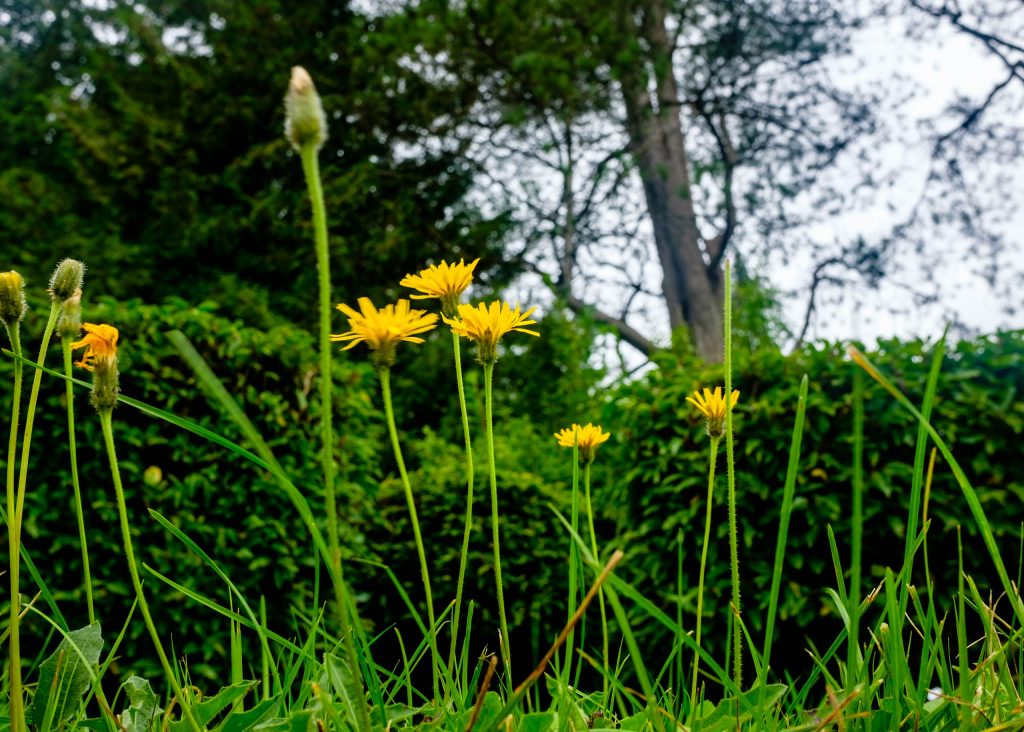 Catsear weed is a perennial herb, most found in cooler to temperate areas of Australia. The name ‘cat’s ear’ comes from the dense hairs that cover the plant’s leaves. It flowers throughout the summer and can become quite a problem in thin, open areas. It reproduces by seed, and each plant can produce as many as 6000 seeds. Soil moisture and light are required for germination, and most seeds will germinate in autumn.
Catsear weed is a perennial herb, most found in cooler to temperate areas of Australia. The name ‘cat’s ear’ comes from the dense hairs that cover the plant’s leaves. It flowers throughout the summer and can become quite a problem in thin, open areas. It reproduces by seed, and each plant can produce as many as 6000 seeds. Soil moisture and light are required for germination, and most seeds will germinate in autumn.
When it comes to controlling grass weeds in your lawn, there are several options, depending on the type of grass weed, and the level of infestation. In this section, we will go through the different options for safe and effective grass weed control.
Lawn herbicides are a category of weed killers that can be used to safely eradicate weeds in your lawn, without destroying the lawn itself. Broad spectrum, or non-selective herbicides, like glyphosate, are very effective at killing weeds, but they will also kill your grass.
Selective lawn herbicides are designed to specifically target only one or two weeds, while having minimal impact on the lawn. For this reason, it is very important to be able to identify the weed you are tackling, so you can select the right herbicide for its control.
It is equally important that you know about the lawn variety that you are treating. The mechanism of action of each selective herbicide is slightly different – this is how it can kill some weeds, while leaving your lawn intact – however, there may be times when a particular lawn herbicide is not suitable for your lawn variety. You should carefully read the label before use, and if unsure, seek professional advice.


Barricade 1L is a pre-emergent liquid herbicide that controls a wide range of weeds and is suitable for use on Zoysia, Kikuyu, Buffalo and Couch grasses. Always read the safety directions and instructions on the product label before use.
SHOP NOW
Bow and Arrow 500mL is one of the most effective broadleaf liquid herbicides on the market. Suitable for Zoysia, Kikuyu, Couch and Buffalo grasses however transient discolouration may occur on Kikuyu, Carpet and Queensland Blue Couch lawns. Always read the safety directions and instructions on the product label before use.
SHOP NOWFor more information on leading herbicide treatments for your home lawn, visit myhomeTURF’s online store.
 The best time to apply herbicides to your lawn depends on the weed you are trying to kill. Most lawn herbicides work by interrupting the lifecycle of the plant. In most cases, you’ll want to apply the herbicide prior to the weed reaching maturity, so that you can prevent it from dispersing its seed.
The best time to apply herbicides to your lawn depends on the weed you are trying to kill. Most lawn herbicides work by interrupting the lifecycle of the plant. In most cases, you’ll want to apply the herbicide prior to the weed reaching maturity, so that you can prevent it from dispersing its seed.
Pre-emergent herbicides work by preventing weed seeds from germinating, and should be applied before seeds begin to germinate, usually in early spring.
Post-emergent herbicides work by absorbing into the plant itself, usually through the leaves. This category of weed killer is most effective on young, vulnerable plants, so spraying is best undertaken on the appearance of new growth.
Other considerations when applying herbicides include rainfall – some herbicides require rain to be activated, while others need a spell of dry weather to work optimally; wind – you should avoid spraying herbicides on a windy day to avoid drift; and timing of other maintenance on your lawn.
The speed at which grass weeds die following the application of a herbicide can depend on several factors, including the maturity of the weed, the size of the infestation, and the health of your lawn.
If applied correctly, you will start to see the effect of the weed killer within 2-3 weeks of application. The weeds may take longer to die off completely and may require subsequent applications 6-8 weeks later for large, persistent weed infestations.
In some cases, it may be appropriate, or more desirable, to manage grass weeds manually. This may depend on the type of grass weed, the level of weed infestation, and the variety of lawn you are growing.
Most manual methods involve using your hands, or an implement, to dig the weed out of the ground, removing the entire root system. This can be a tedious task and may not be feasible if you are dealing with many weeds. If you do decide to remove your weeds manually, always remove seed heads from weeds, and make sure to completely remove the entire weed root system, to make sure that your lawn does not become infested again.
Other natural approaches to getting rid of grass weeds include boosting the health of your lawn to help it out-compete the weeds. Regular watering, fertiliser application, and general maintenance of your lawn will enhance the quality of your soil, and encourage healthy grass growth, leaving little room for weeds to take hold. This preventative approach is a sustainable way to reduce the weed burden and will result in a thriving lawn.